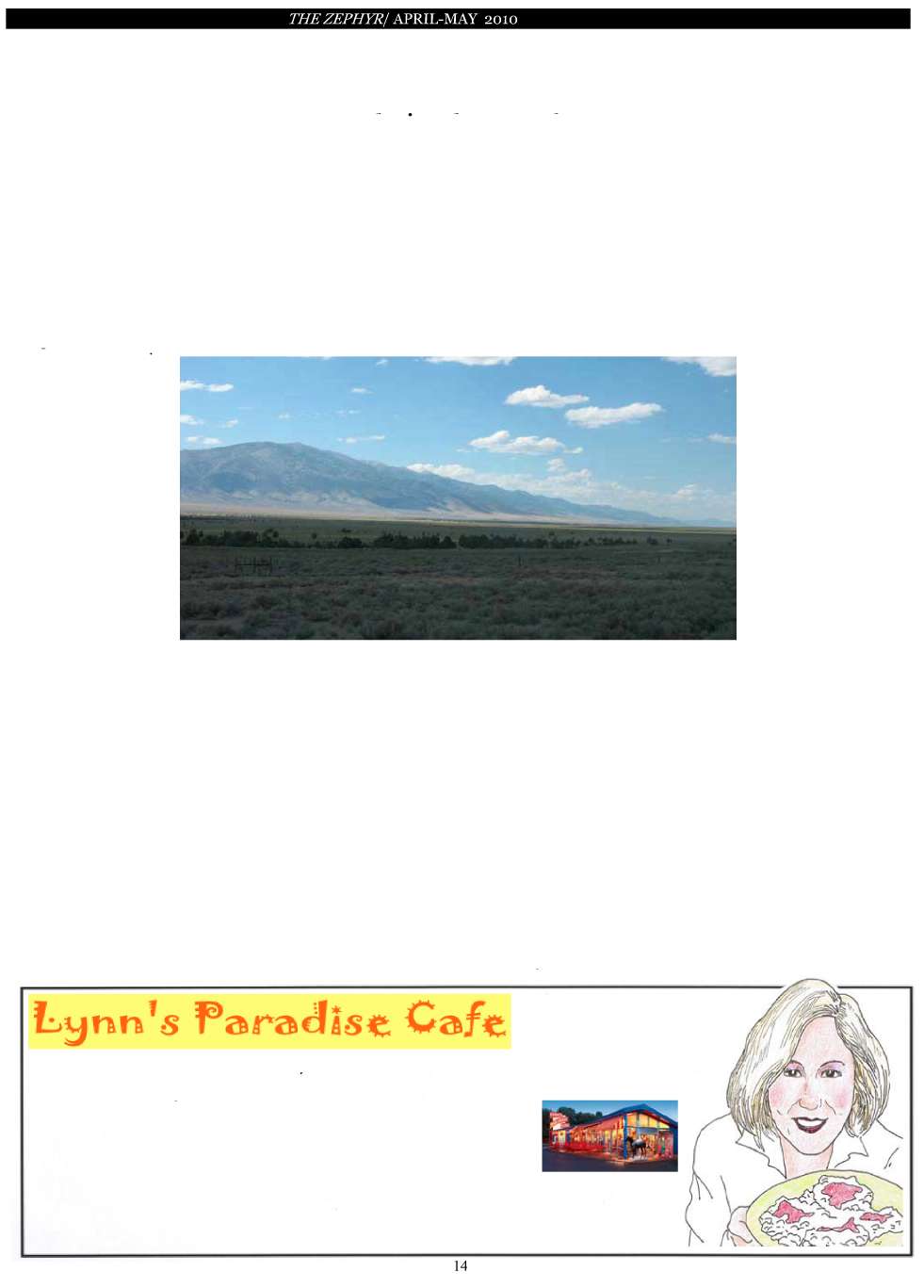<<Prev Home PDF Next>>

Trading Wildlife for Wind Energy
by Kevin Emmerich and Laura Cunningham
At
Carlsbad Caverns National Park, New Mexico, Park Rangers celebrate the
ancient but nightly midsummer ritual of Brazilian free-tailed bats
exiting the cave in an ecological insect feeding frenzy. Starting in
late summer, a similar, less recognized event occurs in Nevada next to
Great Basin National Park in a smaller cave providing a roosting colony
for one million Brazilian free tailed bats. Once a fertilizer mine in
the 1920's, the Rose Guano Cave has now been closed to mining guano by
the Bureau of Land Management (BLM), and recognized as an important
landmark to the survival of this population. It does indeed seem ironic
that the BLM now considers this cave and its bats a resource that must
be "adaptively managed".
we
thought the junipers were beautiful!) The one percent figure is
ridiculous. The project area is rich in wildlife and is used by mule
deer, prong-horn, and even elk have been observed close to the site.
When one of us (Kevin) worked at Great Basin National Park, the park
biologist thought golden eagles in Spring Valley were like "chickens"
and it was true. On any day, a visitor could see at least two or three
from the highway. Raptors commonly glide over the valley and
surrounding mountains: peregrine falcons, ferruginous hawks, and even
bald eagles, which are common winter residents. How tragic that the BLM
has made protecting this symbol of the United States a second priority
to subsidizing inneficient energy boondoggles (accord-
In
January, 2006, Sprrng Valley Wind LLC began testing a section of the
remote Spring Valley, 12 miles from the boundary of Great Basin
National Park, to construct 8,500 acres of 400-foot-tall wind turbines.
In their best case scenario, 80 of these turbines would sell 149
megawatts of electricity to Las Vegas where green energy may someday
provide power to the parking garage lights of the Mandalay Bay resort
and casino.
ing
to the California Energy Commission, wind farms there have put out about
25% of their maximum rated capacity in the last few decades), the Wind
energy developers claim that the new design of turbines prevent raptor
mortality, yet the following video of a vulture colliding with a
turbine in Spain tells a more accurate
story: http://www.windaction.org
/videos/23904.
story: http://www.windaction.org
/videos/23904.
Wind energy developers consistently underplay the
Aside
from being approximately one mile from the Rose Guano Cave, these huge
wind turbines would include large "lay down" areas" of bladed habitat
for construction of turbines, 28 miles of new 68-foot-wide roads, fiber
optic line trenches, plus microwave towers, substations, maintenance
facilities and employee parking lots. Each turbine foundation would
have 120 tons of cement. Cement, of course, needs water and the peak
usage of water per construction would be 700,000 gallons or about 25
acre feet. This area is famous for outsiders seeking to waste water.
The Southern Nevada Water Authority hopes to pipe a significant amount
of the groundwater of this region to the casinos and housing
developments in Las Vegas, making the only water available a temporary
lease of water rights from the LDS Church. The project would be
located next to the Swamp Cedar Area of Critical Environmental Concern,
a rare habitat with spring wetlands and junipers growing on the basin
floor. The BLM admits that placing large, heavy concrete foundations
for turbines would draw the water down and away from the springs.
In
spite of all these impacts, BLM has assured us that only one percent of
the total land area would be disturbed. (They also found it amazing that
impacts
large wind farms would have on sage grouse by saying that few
individuals die in rotor collisions, in a clever attempt to deflect the
larger impacts of wind developments fragmenting vast patches of
old-growth sagebrush habitats needed by the birds for breeding. Roads,
foundation pads for turbines, herbicide treatments, all have documented
negative effects to sagebrush stands and sage grouse populations. Due
to the controversy of both fossil-fuel and renewable energy
development across the sagebrush sea, the Fish and Wildlife Service is
again being forced to review the petition to list the species as
federally threatened. Pygmy rabbits, requiring tall, dense sagebrush
stands for cover, were found on the site. The BLM review stated that
they would have to move.
Bat
Conservation International studies show how bats may even be attracted
to wind turbines as possible new perch sites and insect foraging areas,
but make deadly collisions with rotors, both slow- and fast-moving.
Pressure from rotating turbines has been found to expand the lungs of
bats, causing death.
We
stood on the side of the highway on a cold fall day with BLM
personnel, looking across the wide basin that would be studded with
steel tur-
"One of the four most fun restaurants in America"
984 BARRET AVE LOUISVILLE, KENTUCKY!
Esquire (June 2002)
502.583.3447
"Still only 1531 miles from Moab!"
Don't
miss Frenzy at the Finish the day after Derby entertainment all day
long, special drinks, a new chef, Jeremy Harrel with great new specials
AND the Derby winner to have photos made with!
For a good time call Patty "The Instigator" at 502-821-8888
or email her Patty@lynnsparadisecafe.com to plan your next celebration!
<<Prev Home PDF Next>>